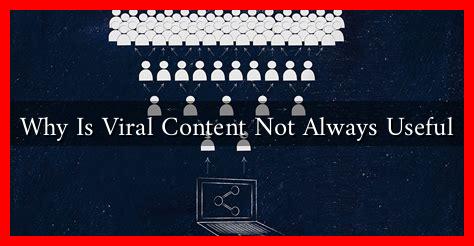-
Table of Contents
Why Is Viral Content Not Always Useful?
In the age of social media, the term “viral content” has become synonymous with success. Marketers and content creators often chase the elusive goal of creating something that will spread like wildfire across the internet. However, while viral content can generate significant attention and engagement, it is not always useful or beneficial. This article explores the reasons why viral content may fall short of its intended purpose and the implications for brands and audiences alike.
The Nature of Viral Content
Viral content is typically characterized by its ability to reach a large audience in a short amount of time. It often evokes strong emotional responses, whether through humor, shock, or inspiration. However, the very qualities that make content go viral can also render it less useful. Here are some key factors to consider:
- Surface-Level Engagement: Viral content often prioritizes entertainment over substance. While it may attract clicks and shares, it may not provide meaningful information or insights.
- Short-Lived Attention: The lifespan of viral content is often fleeting. What captures attention today may be forgotten tomorrow, leading to a lack of long-term engagement.
- Misalignment with Brand Values: Brands that chase viral trends may find themselves promoting content that does not align with their core values, potentially alienating their audience.
Case Studies: When Viral Content Misses the Mark
Several high-profile examples illustrate the pitfalls of viral content. One notable case is the infamous Pepsi advertisement featuring Kendall Jenner, which aimed to convey a message of unity and peace. Instead, it was widely criticized for trivializing social justice movements, leading to a backlash that overshadowed any initial engagement the ad received. This incident highlights how viral content can backfire when it fails to resonate authentically with its audience.
Another example is the “Ice Bucket Challenge,” which went viral in 2014 to raise awareness for ALS. While it successfully generated millions in donations, many participants engaged in the challenge without understanding the cause, leading to questions about the effectiveness of awareness campaigns that prioritize virality over education.
The Metrics of Success: Beyond Virality
Measuring the success of content solely by its virality can be misleading. Here are some alternative metrics that can provide a more comprehensive view of content effectiveness:
- Engagement Quality: Instead of focusing on likes and shares, consider comments and discussions that indicate deeper engagement.
- Conversion Rates: Assess how well the content drives desired actions, such as sign-ups, purchases, or downloads.
- Brand Sentiment: Monitor how the audience perceives the brand after engaging with the content, ensuring alignment with brand values.
The Importance of Authenticity and Value
To create content that resonates and provides value, brands should prioritize authenticity and relevance. Here are some strategies to consider:
- Know Your Audience: Conduct thorough research to understand your audience’s needs, preferences, and pain points.
- Focus on Storytelling: Craft narratives that connect emotionally with your audience while providing valuable insights or solutions.
- Encourage User-Generated Content: Foster a community where your audience can share their experiences and stories, enhancing authenticity.
Conclusion: The Balance Between Virality and Value
While viral content can offer a temporary boost in visibility, it is essential to recognize that not all viral content is useful. Brands should strive for a balance between creating engaging content and providing real value to their audience. By focusing on authenticity, quality engagement, and alignment with brand values, marketers can create content that not only goes viral but also fosters lasting connections with their audience.
In a world where attention is fleeting, the true measure of success lies not in the number of shares but in the impact and value delivered to the audience. For more insights on effective content strategies, consider exploring resources from HubSpot or Content Marketing Institute.


